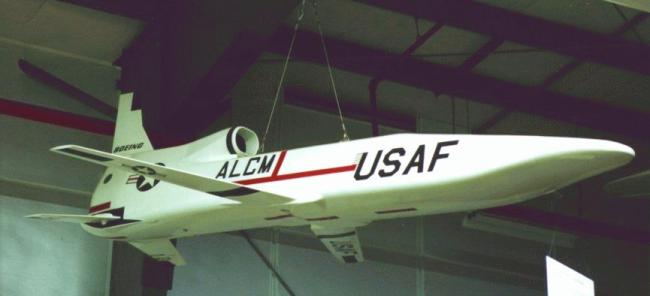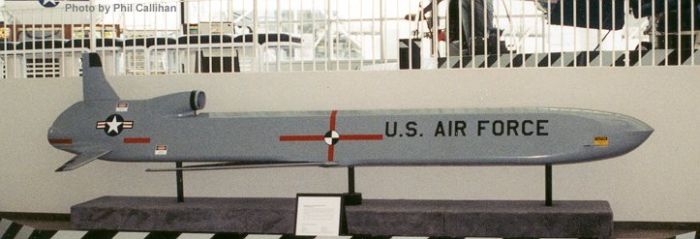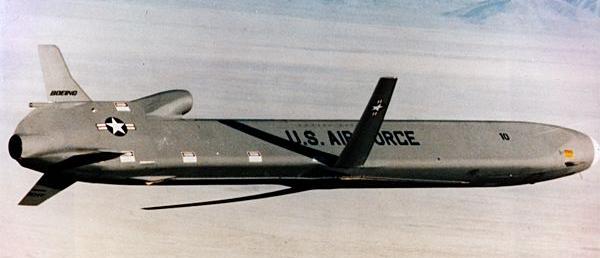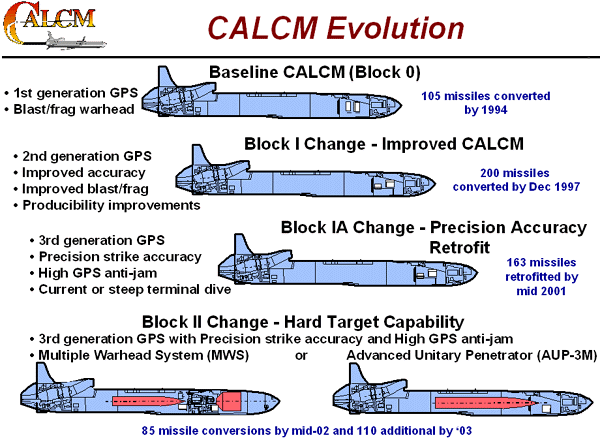Boeing AGM-86 ALCM
The AGM-86 ALCM (Air-Launched Cruise Missile) is the major long-range standoff attack missile of the U.S. Air Force's B-52H Stratofortress strategic bombers. With the conversion of nuclear armed rounds to conventional warheads, the AGM-86 will remain a very important weapon for the foreseeable future.
Development of the ALCM can be traced back to January 1968, when the USAF drew up a requirement for a vehicle called SCAD (Subsonic Cruise Aircraft Decoy). SCAD was to be a decoy missile carried by B-52 and B-1A bombers, which was to simulate the bombers on radar to disrupt enemy air-defense systems. As such, it was essentially a follow-on to the ADM-20 Quail decoy. Early in the concept phase it became clear that SCAD could also be fitted with a small nuclear warhead, and the acronym was accordingly changed to Subsonic Cruise Armed Decoy. Full scale development was approved in July 1970, and the designation ZAGM-86A was assigned to SCAD. In the early 1970s, however, the expected cost of SCAD's advanced electronic systems rose dramatically. In June 1973, development was halted after it had become clear that it was more cost effective to develop a pure attack cruise missile without any decoy capability.
Following SCAD's cancellation, the USAF immediately started a new program for a long-range nuclear-armed air-launched cruise missile, using SCAD as a starting point. In September 1974, Boeing was awarded a contract to develop the new missile. The designation AGM-86A was retained, because the new ALCM was essentially an armed SCAD. The AGM-86A was only 4.3 m (14 ft) long and could therefore be used with the same launchers as the AGM-69 SRAM. The first powered flight occured in March 1976, and the first fully guided flight succeeded in September that year. The AGM-86A used an inertial navigation system together with a TERCOM (Terrain Contour Matching) system.
 |
| Photo: Aviation History Online Museum |
| AGM-86A |
During AGM-86A development, the USAF had already issued a requirement for an extended range (2400 km (1500 miles)) missile. There were two viable options to achieve this, either by using external fuel tanks with an essentially unchanged AGM-86A, or with a new lengthened missile called ERV (Extended Range Vehicle). The ERV had the drawback that existing external AGM-69 SRAM launchers could not be used, and that the missile would fit no longer into the bomb bay of the B-1A. The Air Force therefore decided to field the AGM-86A first, later to be followed by either the external tank missile or the ERV. In January 1977, the AGM-86A was cleared for full-scale production, but this was not to be, because 1977 saw another drastic change in the direction of the ALCM program.
Under a program called JCMP (Joint Cruise Missile Project), the USAF and the U.S. Navy were directed to develop their cruise missiles using a common technology base. At that time the Navy had just declared the BGM-109 Tomahawk as winner of its SLCM (Sea-Launched Cruise Missile) competition. One consequence of JCMP was that only one cruise missile propulsion system (the Williams F107 turbofan of the AGM-86) and TERCOM guidance system (the McDonnell Douglas AN/DPW-23 of the BGM-109) would be further developed. Another one was the cancellation of the short-range AGM-86A, together with a directive to select a long-range ALCM from a competition between the ERV ALCM (now designated AGM-86B) and an AGM-109 air-launched version of Tomahawk. The first flight of an AGM-86B occurred in August 1979, and in March 1980 the AGM-86B was declared winner of the fly-off with the AGM-109. Full-scale production started soon after, and in August 1981, the ALCM was operational with the B-52G/H Stratofortress.
 |
| Photo: Phil Callihan |
| AGM-86B |
The AGM-86B is powered by a single Williams F107-WR-100 or -101 turbofan engine, and armed with a W-80-1 variable-yield thermonuclear warhead. It is equipped with a Litton P-1000 inertial navigation system, which is updated until immediately before launch by the B-52's INS. The wings and control surfaces are folded to the fuselage, and are unfolded in about 2 seconds after launch. Once at low-level, the AGM-86B uses its McDonnell Douglas AN/DPW-23 TERCOM system to find its way to the target. In a TERCOM system, altitude information obtained by a radar altimeter is continuously matched to a preprogrammed radar map of the area below the missile, so that the ALCM can effectively follow a detailed predetermined flight path. The accuracy of the whole guidance system is probably between 30 m (100 ft) and 90 m (300 ft) CEP. B-52Hs equipped with the new CSRL (Common Strategic Rotary Launcher) in the bomb bay can carry up to 20 ALCMs, 8 on the CSRL and a further 12 on two wing pylons.
When production ended in 1986, Boeing had delivered more than 1700 AGM-86B ALCMs. Because the intended successor, the AGM-129 ACM was built in much smaller numbers than anticipated, the AGM-86 will remain in the USAF's arsenal for the quite some time, although most of them will be converted to CALCMs, which see below.
In 1986, Boeing began converting some AGM-86Bs to AGM-86C standard. The main change is the substitution of the nuclear warhead with a conventional 900 kg (2000 lb) class blast-fragmentation warhead, and the AGM-86C is therefore also known as CALCM (Conventional ALCM). It is rather convenient that the C suffix of the designation can also be read as "Conventional", but other than most press releases may suggest, this is pure coincidence. The AGM-86C is also equipped with a GPS receiver for significantly increased accuracy. The AGM-86C was used very successfully during Operation Desert Storm in 1991, and in the NATO's war against Serbia in 1999. Because the CALCM is heavier than the nuclear ALCM, range is significantly reduced.
 |
| Photo: Boeing |
| AGM-86C |
The original AGM-86C is known as CALCM Block 0. A new Block I configuration, using improved avionics and GPS receiver and a larger 1450 kg (3000 lb) blast-fragmentation warhead, was successfully tested in 1996, and all existing Block 0 missiles were upgraded to Block I configuration. Block IA is a further improvement to achieve very high precision terminal guidance. It features an extremely accurate optimized multi-channel GPS receiver, and also incorporates enhanced shallow and steep terminal dive capability. The projected accuracy is said to be 3 m (10 ft). Development of Block IA started in 1998, and the first missiles were delivered to the USAF in January 2001. More than 300 ALCMs have already been converted to AGM-86Cs, and Boeing has contracts to convert several hundred more to CALCM Block I/IA configuration. The DATM-86C is a handling and loading practice variant of the CALCM with completely inert warhead and propulsion sections.
The AGM-86D CALCM Block II is equipped with a new Lockheed Martin 540 kg (1200 lb) AUP (Advanced Unitary Penetrator) penetrating warhead for use against deeply buried and/or hardened targets. The first flight test of an AGM-86D occurred in November 2001, and it is currently planned to produce almost 200 CALCMs as AGM-86Ds.
 |
| Image: Boeing |
| AGM-86C/D CALCM versions |
Specifications
Note: Data given by several sources show slight variations. Figures given below may therefore be inaccurate!
Data for AGM-86B (except where noted):
| Length | 6.32 m (20 ft 9 in) |
| Wingspan | 3.66 m (12 ft) |
| Diameter | 62 cm (24.5 in) |
| Weight | 1450 kg (3200 lb) AGM-86C Block I: 1950 kg (4300 lb) |
| Speed | 800 km/h (500 mph) |
| Range | 2400 km (1500 miles) AGM-86C Block I: 1200 km (750 miles) |
| Propulsion | Williams F107-WR-101 turbofan; 2.7 kN (600 lb) |
| Warhead | W-80-1 thermonuclear (5-150 kT) AGM-86C Block I: 1450 kg (3000 lb) HE blast-fragmentation AGM-86D: 540 kg (1200 lb) hard-target penetrator |
Main Sources
[1] James N. Gibson: "Nuclear Weapons of the United States", Schiffer Publishing Ltd, 1996
[2] Bill Gunston: "The Illustrated Encyclopedia of Rockets and Missiles", Salamander Books Ltd, 1979
[3] Christopher Chant: "World Encyclopaedia of Modern Air Weapons", Patrick Stephens Ltd., 1988
[4] Hajime Ozu: "Missile 2000 - Reference Guide to World Missile Systems", Shinkigensha, 2000
[5] Boeing CALCM Website
Back to Current Designations Of U.S. Unmanned Military Aerospace Vehicles
Back to
Directory of U.S. Military Rockets and Missiles
Last Updated: 25 March 2002